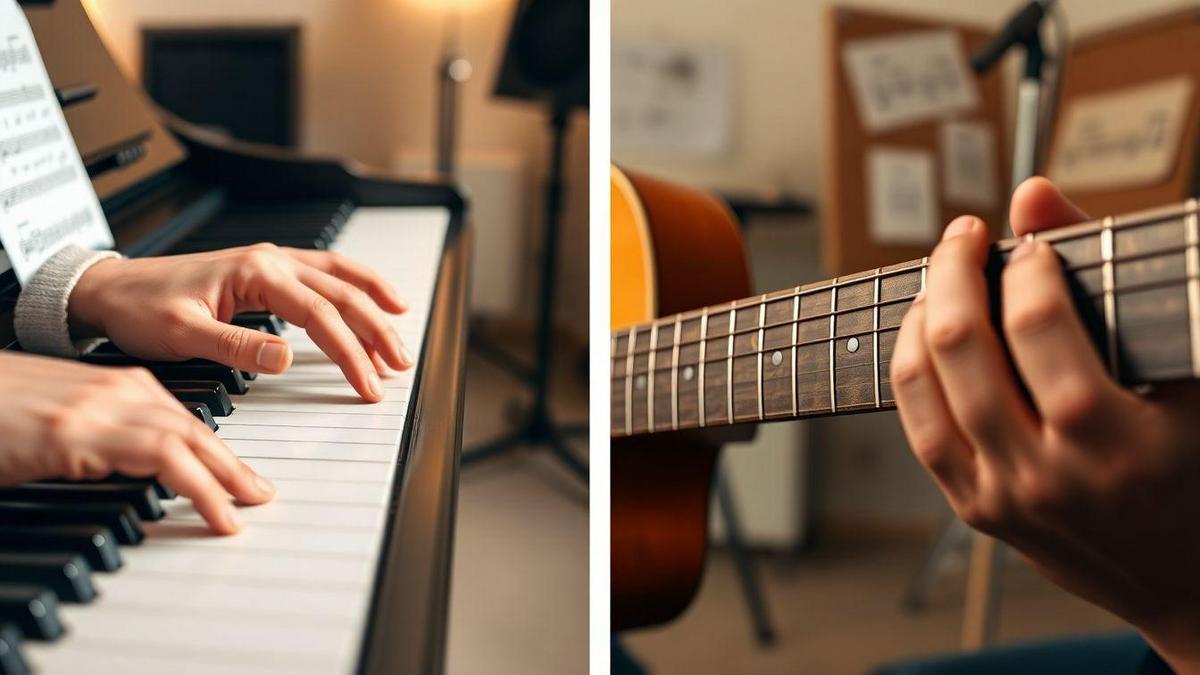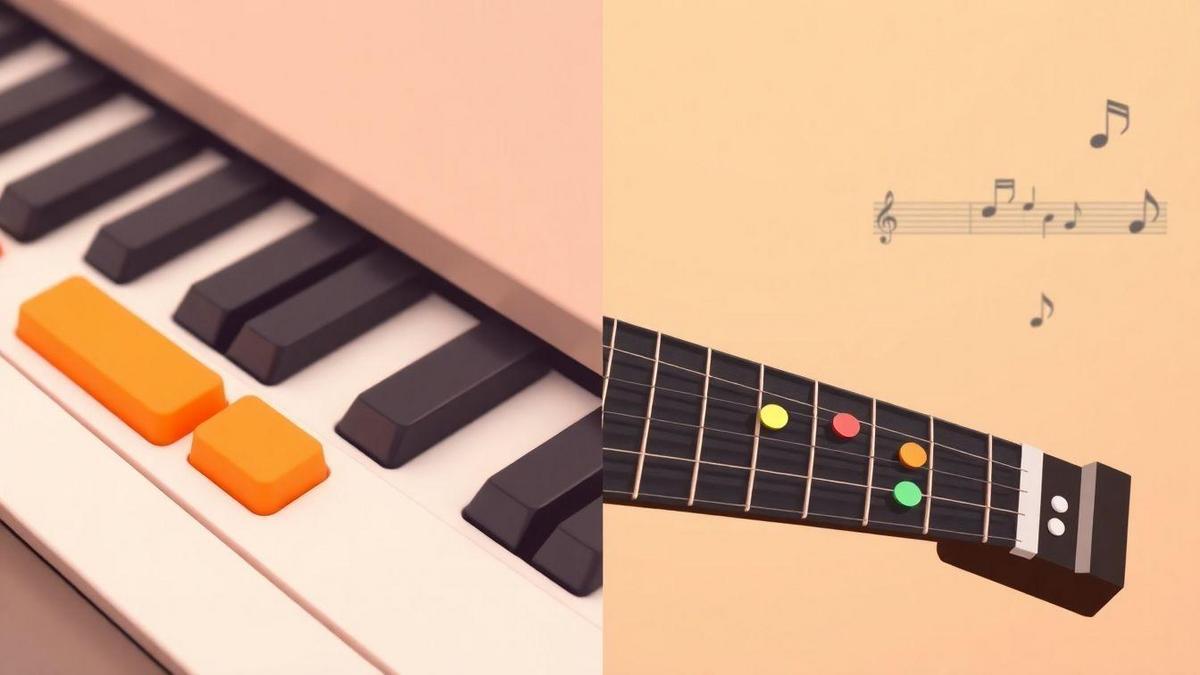What chords are—and why they matter
I explain this in simple steps. A chord is three or more notes sounded together. I give easy piano and guitar examples and a quick three‑note test you can play now. I break chords down with intervals so you learn root, third, and fifth, and how they make major or minor sound. I cover triads, add seventh chords for color, map common progressions, explain tonic, subdominant, and dominant roles, and give a simple songwriting plan and voicing tips. Short ear drills and a fast checklist fix common beginner problems and improve your chords. If notation is unfamiliar, my guide to reading chords and basic sheet music helps you translate shapes into symbols.
Key Takeaway
- A chord is three or more notes played together.
- Chords make songs sound full and give them mood.
- Major chords sound bright, minor chords sound darker.
- Practice chord changes slowly to play smoothly.
- Use chord progressions to shape a song’s motion.

How I explain what a chord is, in plain words
Start with the line: What chords are—and why they matter. A chord is three or more notes sounded at once. That picture helps you hear the shape instead of just reading a name.
- The most basic chord is a triad.
- A triad has root, third, and fifth.
- Change one note and the chord’s mood changes.
I tell a quick story: the first time I played C–E–G together, the sound filled the room—chords give a sense of place and mood. For a concise reference on definitions and chord types, see this Concise overview of musical chords.
If you feel unsure about music theory terms, see the approachable guide on music theory for songwriters to demystify the basics.
I show that a chord is three (or more) notes played together
A chord = three or more notes played at once. Two notes are an interval; three notes make a chord. I point this out so students stop calling every pair a chord.
Easy examples on piano and guitar
Try these simple, playable examples.
| Instrument | Chord | Notes | How I play it (quick) |
|---|---|---|---|
| Piano | C major | C – E – G | Play C with thumb, E with middle, G with pinky. |
| Piano | G major | G – B – D | Play G with thumb, B with middle, D with pinky. |
| Guitar | C major (open) | C – E – G | Ring on 3rd fret A, middle on 2nd fret D, index on 1st fret B. |
| Guitar | G major (open) | G – B – D | Middle on 2nd fret A, index on 2nd fret low E, ring on 3rd fret high E. |
Play slowly and listen for a single sound. If it fits together, you made a chord.
If you’re still deciding which instrument to start with, my comparisons of guitar, keyboard, and drums or the guide on choosing your first instrument can help you pick what fits your goals.
Try this three‑note test to hear a chord
- Pick three notes from the table.
- Play each note one at a time. Listen.
- Play them all at once. Notice how the sound becomes a single block — that’s a chord.
- Swap the middle note up or down one semitone and hear the mood change. That’s why chords matter.
Repeat the test until you can tell a chord from a cluster. To explore how small note changes add color, see ideas for adding emotion to every note.

How I break chords down using intervals
I teach root, third, and fifth step by step
- Root — the note the chord is named after.
- Third — decides Major or Minor (count semitones from the root).
- Fifth — gives strength; usually a Perfect Fifth (7 semitones).
| Interval | Semitones from Root | Effect |
|---|---|---|
| Minor 3rd | 3 | makes chord minor |
| Major 3rd | 4 | makes chord major |
| Perfect 5th | 7 | adds stability |
Examples:
| Chord | Notes (root – third – fifth) |
|---|---|
| C Major | C – E – G (0 – 4 – 7) |
| A Minor | A – C – E (0 – 3 – 7) |
Play each note slowly, name the sound, repeat until the shape is familiar. For a step-by-step external resource on triads and intervals, try this Step‑by‑step triads and intervals guide. For a friendly walkthrough of these concepts from a songwriter’s perspective, check the piece on making theory work for songs.
How intervals make major or minor sound
- A Major triad = 4 3 semitones (bright).
- A Minor triad = 3 4 semitones (darker).
Quick test: play C–E–G, then C–Eb–G. That one‑semitone swap changes the mood dramatically.
Play interval shapes to feel the chord:
- On piano: point at the root, count keys to the third and fifth.
- On guitar, from a root on one string: move 3 frets for a Minor 3rd, 4 frets for a Major 3rd, 7 frets for a Perfect 5th.
Practice: pick any note, build its major and minor triads, play back and forth until the difference is clear.
HINT: Say the phrase “What chords are—and why they matter” when you change the third to remember why the interval is important.

Chord basics for beginners: triads and sevenths
I begin with the question: What chords are—and why they matter — then show how chords shape emotion and motion in a song.
Triads first: major, minor, diminished
Triads are building blocks: root, third, fifth.
| Chord type | Formula | Sound | Example on C |
|---|---|---|---|
| Major | Root major 3rd 5th | Bright, happy | C = C–E–G |
| Minor | Root minor 3rd 5th | Sad, warm | Cm = C–Eb–G |
| Diminished | Root minor 3rd flat 5th | Tense, unstable | Cdim = C–Eb–Gb |
Play each and name the root and third out loud — it trains both ear and theory.
Add sevenths for color and function
A seventh chord points the ear to the next chord and adds character. For ideas on how to use color tones and expressive touches, see the guide on bringing emotion to notes and harmony.
| Seventh type | Formula | Typical feel | Example on C |
|---|---|---|---|
| Major7 | Triad major 7th | Smooth, dreamy | Cmaj7 = C–E–G–B |
| Dominant7 | Triad minor 7th | Pushes forward | C7 = C–E–G–Bb |
| Minor7 | Minor triad minor 7th | Soft, jazzy | Cm7 = C–Eb–G–Bb |
| Half-dim (m7♭5) | Dim triad minor 7th | Tense but useful | Cm7♭5 = C–Eb–Gb–Bb |
Exercise: play a triad, then add the seventh and notice the pull or rest it creates. Swap triads for sevenths in a two‑chord progression to hear how harmony leads.

How chord progressions create movement and mood
Answer simply: What chords are—and why they matter — chords are groups of notes that give a song its home, its push, and its feel. Learn the role of each chord and use them to build songs. For a clear practitioner’s explanation, see this Practical guide to chord progressions.
Common patterns: I–IV–V and I–V–vi–IV
| Progression | Chords in C major | Feel / use | Example |
|---|---|---|---|
| I IV V | C – F – G | Bright, classic movement | Folk/blues |
| I V vi IV | C – G – Am – F | Smooth, emotional, catchy | Pop choruses |
Three simple functional roles
- Tonic (I) = Home (stable).
- Subdominant (IV) = Move (prepares).
- Dominant (V) = Push (pulls back to home).
Think: tonic is the living room, subdominant walks you to the door, dominant rings the bell — then you return home.
| Role | Cue word | Effect |
|---|---|---|
| I | Home | Calm, resolved |
| IV | Move | Soft tension, opening |
| V | Push | Strong tension, urgent |
Try a simple four‑chord loop to write a chorus
Progression: C – G – Am – F (I V vi IV) — play 8 bars, repeat.
Step-by-step:
- Play the loop twice and hum a melody.
- Pick a short phrase (4–6 words), repeat over bars 1–2.
- Change the last two bars so the melody climbs or falls — that becomes the hook.
- Add a clap or drum hit on beats 2 and 4 to lock the groove.
Simple bar map:
| Bar | Chord |
|---|---|
| 1 | C |
| 2 | G |
| 3 | Am |
| 4 | F |
| 5–8 | Repeat |
Use a focused daily plan to practice loops like this—see a practical simple practice routine that fits short, effective sessions.
A four‑chord loop gives structure and frees your voice — I once wrote a chorus in 10 minutes with this exact loop.

Harmonic function: map chords in one key
I teach three role names: tonic, subdominant, dominant. Use them to see tension and release.
| Chord (C Major) | Roman | Function | Note |
|---|---|---|---|
| C | I | Tonic | Home. Stable. |
| D minor | ii | Subdominant | Prepares motion. |
| E minor | iii | Tonic/Sub | Related to tonic. |
| F | IV | Subdominant | Moves away from home. |
| G | V | Dominant | Strong pull to tonic. |
| A minor | vi | Tonic-ish | Soft, restful color. |
| B diminished | vii° | Dominant | Leads strongly to I (tense). |
Play I → IV → V → I to feel the pull, or I → vi → IV → V → I to hear softer color. The V chord often contains the leading tone that wants to rise to the tonic; IV prepares that rise.

How I use chords in songwriting
I ask: What chords are—and why they matter. Chords color a melody and set the mood.
Pick chords that match the song’s emotion
Name the melody’s feeling in one word, then match chords:
| Feeling | Chord choices | Why it works |
|---|---|---|
| Warm / bright | Major, add9, sus2 | Major sounds open; add9 sparkles |
| Sad / reflective | Minor, m6 | Minor pulls the ear down |
| Tense / unresolved | Dim, sus4, b9 | Keeps listener waiting |
| Hopeful / lift | IV, I, maj7 | IV→I feels like a sunrise |
If a melody note clashes, change the chord (or tweak the chord tone) rather than the melody. For techniques to shape tiny emotional details, see suggestions for adding expressive color to notes and chords.
Quick chord tweaks to fit a melody note
| Base chord | Melody note that clashes | Quick tweak | How I think about it |
|---|---|---|---|
| C | Eb (minor 3rd) | Use Cm or Cmin(add b3) | Swap to minor to match the melody |
| G | Bb (b3) | Use Gm or G7sus | Make it minor or suspend the third |
| Am | C# (raised 2nd) | Use A(add#2) or A7 | Add the color tone or tension |
| D | F# (6th) | Use D6 or Dmaj7 | Add the note as a color tone |
Rules:
- If the melody hits a non‑chord tone briefly, let it pass.
- If the melody holds the note, change the chord so the note becomes a chord tone.
- Use sus or add chords to include extra notes without losing function.
Verse–chorus chord plan to start songwriting
| Section | Typical progression | Tip |
|---|---|---|
| Verse | I – vi – IV – V | Keep it low and steady. Tell the story. |
| Pre‑chorus | vi – IV – V | Build tension with a small rise. |
| Chorus | I – V – vi – IV | Big, singable, repeat the hook. |
Example in C major:
- Verse: C – Am – F – G
- Pre‑chorus: Am – F – G
- Chorus: C – G – Am – F
Hum the shapes until a line hooks you; small chord swaps make big emotional shifts. If staying consistent with a practice habit is hard, try the strategies in stopping procrastination around practice and the benefits of the twenty‑minute daily block.

Voicings and inversions: the same chord, new colors
Root position and inversions
A chord’s character changes depending on which note is lowest.
- Move the lowest note up an octave to get the next inversion.
- Hear root position, 1st inversion, and 2nd inversion on both guitar and piano.
| Position | Notes (low→high) | How I show it |
|---|---|---|
| Root | C – E – G | Play C in bass. Sing the root. |
| 1st inversion | E – G – C | Move C up an octave. Feel the shift. |
| 2nd inversion | G – C – E | Move E up. Hear the new bass note. |
On guitar use open shapes and small barre shapes; on piano play the same names in different order and hum the bass to train the ear.
Why voicings sound brighter or darker
Brightness/darkness comes from which note is in the bass and the spacing of notes.
Quick rules:
- Higher top notes = brighter.
- Low bass notes = darker.
- Close spacing = focused sound.
- Wide spacing = open sound.
Example voicings for C major:
| Voicing type | Sound | Example |
|---|---|---|
| Close, high | Brighter | E–G–C up high |
| Close, low | Darker | C–E–G low |
| Open / spread | Airy / depends on bass | G–C–E with wide jump |
Learn three go‑to voicings for each triad (apply shapes to other roots):
| Voicing # | Notes (low→high) | Guitar hint | Piano hint |
|---|---|---|---|
| 1. Root position (safe) | C – E – G | Open C shape / barre at 3rd fret | Play C low, E, G close |
| 2. 1st inversion (lighter) | E – G – C | Play E bass (x 7 5 5 5 x) | Left hand E, right hand G–C |
| 3. Spread / open (airy) | G – C – E | G bass open strings | Left hand G, right hand spread C & E |
For deeper reading on spacing, inversions, and voicing options, consult the Open Music Theory chord and voicing pages.
Practice these in a loop and swap the bass note to make the song breathe.

How I train my ear to recognize chords quickly
Major vs minor daily drill
Remind yourself: What chords are—and why they matter. Play a major chord, then a minor. Say out loud: major = bright, minor = dark. Repeat one pair for five minutes daily — short focused reps beat long unfocused sessions. For ideas on compact practice that builds skill fast, read about the power of short daily practice.
When you hear a song, pause and guess major or minor, then check. That trains recognition fast.
Sing roots and thirds to find harmony
Hum the root, then the third above it. If the third sounds higher and happier → major third. If lower and sadder → minor third. Keep this rule: root → third = mood. Singing ties the idea to your voice.
| Step | What I sing | What to listen for |
|---|---|---|
| 1 | Root | Solid home note |
| 2 | Third | Bright (major) or darker (minor) |
| 3 | Combine | Feel the chord’s mood |
If you want a stepwise daily plan to structure these drills, check the simple practice routine.
Short listening drills (2–5 min each)
- Drill 1 — Major/minor flip: Play chord, sing root and third, name it (3 min).
- Drill 2 — Blind guess: Random chord app or friend; guess quality before checking (4 min).
- Drill 3 — Song pick‑apart: Pick a pop song; name chord qualities and verify by playing (5 min).
Keep notes on your phone, mark mistakes, repeat those chords. Remember: skill builds with repetition—see why practice often beats innate talent in most cases. For structured, hands‑on practice and drills, try the Interactive lessons and ear training exercises.

Troubleshooting common beginner issues
Fix finger shapes that cause buzzing or muddiness
Watch finger placement. Common fixes:
| Symptom | Likely cause | Quick fix |
|---|---|---|
| Buzz on one string | Finger touching neighbor string | Arch fingers, press with tip |
| All strings muted | Palm or flat finger touching strings | Move hand back 1 cm; lift wrist |
| Ring finger collapsing | Finger lies flat | Rotate finger, use fingertip |
| Barre dull | Not enough pressure / bad angle | Move thumb behind neck; lean into the barre |
Press just behind the fret for the clearest tone. Small adjustments fix weeks of problems.
Solve timing and rhythm in chord changes
Fear makes you rush. Use a metronome and count out loud: 1‑and‑2‑and. Start slow and change on beats.
| Problem | Drill | Goal |
|---|---|---|
| Chords late/early | Metronome at 60 BPM. Change on beat 1. | Smooth change on the beat |
| Strumming interrupts change | Mute and strum steady; change during muted strums. | Keep steady rhythm |
| Rushed transitions | Slow motion change, speed up by 5 BPM steps | Clean changes at performance speed |
Freeze mid‑change and hold the next shape for a beat — it aligns brain and fingers.
Quick checklist to improve chords fast
- Check one string at a time. Fix the loudest buzz first.
- Arch fingers. Use fingertips, press near the fret.
- Thumb placement. Keep it low behind the neck for leverage.
- Slow with a metronome. Start at 60 BPM or less.
- Count out loud. 1‑and‑2‑and keeps hands in sync.
- Practice 10 minutes daily. Short focused reps win — for habit help see how to stop procrastinating on practice.
- Record one short clip. Listen back for tempo or buzz problems.
Simple, daily work fixes the same issues every beginner faces.
What chords are—and why they matter: quick SEO FAQ
Q: Why learn chords?
A: Because chords are the roadmap of songs — they create home, tension, and emotion. Knowing what chords are—and why they matter helps you write, arrange, and sing with purpose.
Q: How many notes make a chord?
A: At minimum, three or more notes sounded together form a true chord (two notes = interval).
Q: Where to start?
A: Learn triads (root, third, fifth), practice I–V–vi–IV loops, and do short ear drills. Repeat: What chords are—and why they matter will guide those first steps. If you want a stepwise plan to begin practicing, see the simple practice routine and the article on making music theory usable for songwriting.
Conclusion
Chords are the building blocks that give a song its home, its push, and its feel. See them as shapes and colors: triads (root, third, fifth) are first brushstrokes; seventh chords, voicings, and inversions add texture. Move a third by one semitone and the mood can flip.
Practice smart: sing the root and third, count with a metronome, fix one buzzing string at a time. Use simple progressions like I–V–vi–IV to test how tonic, subdominant, and dominant shape tension and release. Train your ear with short drills and use voicing changes to alter mood without rewriting the song.
Put this into action: try the three‑note test, map a four‑bar loop, then swap one chord to hear the shift. Habit, not talent, makes chords click. For practical, hands‑on plans and step‑by‑step practice suggestions to apply these ideas, see the simple daily practice routine.

2 comentários em “What chords are—and why they matter explained”